
The sexual revolution, also known as the sexual liberation, was a social movement that challenged traditional codes of behavior related to sexuality and interpersonal relationships throughout the developed Western world from the 1960s to the 1970s. Sexual liberation included increased acceptance of sex outside of traditional heterosexual, monogamous relationships. The normalization of contraception and the pill, public nudity, pornography, premarital sex, homosexuality, masturbation, alternative forms of sexuality, and the legalization of abortion all followed.
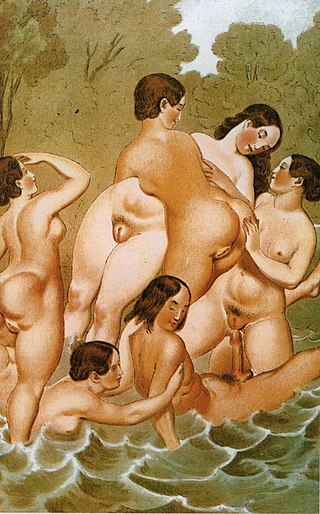
Group sex is sexual activity involving more than two people. Participants in group sex can be of any sexual orientation or gender. Any form of sexual activity can be adopted to involve more than two participants, but some forms have their own names.

Fisting—also known as fist fucking (FF), handballing, and brachioproctic or brachiovaginal insertion—is a sexual activity that involves inserting one or more hands into the rectum or the vagina. Fisting may be performed on oneself (self-fisting) or performed on one person by another. People who engage in fisting are often called "fisters".

The GMHC is a New York City–based non-profit, volunteer-supported and community-based AIDS service organization whose mission statement is to "end the AIDS epidemic and uplift the lives of all affected." Founded in 1982, it is often billed as the "world's oldest AIDS service organization," as well as the "nation's oldest HIV/AIDS service organization."
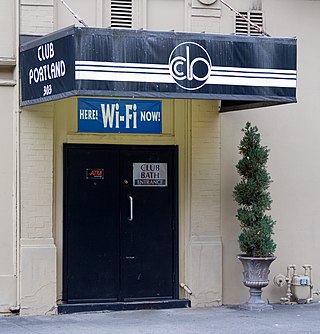
A gay bathhouse, also known as a gay sauna or a gay steambath, is a public bath targeted towards gay and bisexual men. In gay slang, a bathhouse may be called just "the baths", "the sauna", or "the tubs". Historically, they have been used for sexual activity.

Laurence David Kramer was an American playwright, author, film producer, public health advocate, and gay rights activist. He began his career rewriting scripts while working for Columbia Pictures, which led him to London, where he worked with United Artists. There he wrote the screenplay for the film Women in Love (1969) and received an Academy Award nomination for his work.
Sex-positive feminism, also known as pro-sex feminism, sex-radical feminism, or sexually liberal feminism, is a feminist movement centering on the idea that sexual freedom is an essential component of women's freedom. They oppose legal or social efforts to control sexual activities between consenting adults, whether they are initiated by the government, other feminists, opponents of feminism, or any other institution. They embrace sexual minority groups, endorsing the value of coalition-building with marginalized groups. Sex-positive feminism is connected with the sex-positive movement. Sex-positive feminism brings together anti-censorship activists, LGBT activists, feminist scholars, producers of pornography and erotica, among others. Sex-positive feminists believe that prostitution can be a positive experience if workers are treated with respect, and agree that sex work should not be criminalized.
Effeminacy or male femininity is the embodiment of feminine traits in boys or men, particularly those considered untypical of men or masculinity. These traits include roles, stereotypes, behaviors, and appearances that are socially associated with girls and women. Throughout Western civilization, men considered effeminate have faced prejudice and discrimination. Gay men are often stereotyped as being effeminate, and vice versa. However, femininity, masculinity, and other forms of gender expression are independent of sexual orientation.

Plato's Retreat was a heterosexual swingers' club catering to couples. From 1977 until 1985 it operated in two locations in Manhattan, New York City, United States. The first was the former location of the Continental Baths, a gay bathhouse that also showcased artists who went on to great success including Bette Midler, Barry Manilow, and Melissa Manchester.

Faggots is a 1978 novel by Larry Kramer. It is a satirical portrayal of 1970s New York's very visible gay community in a time before AIDS. The novel's portrayal of promiscuous sex and recreational drug use provoked controversy and was condemned by some elements within the gay community.
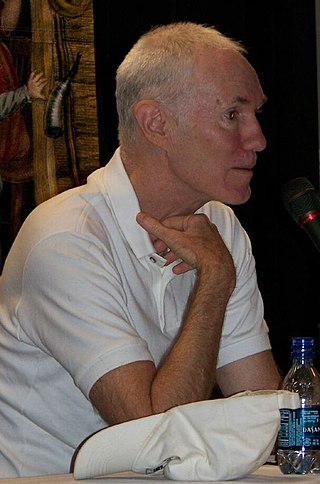
Andrew Holleran is the pseudonym of Eric Garber, an American novelist, essayist, and short story writer, born on the island of Aruba. Most of his adult life has been spent in New York City, Washington, D.C., and a small town in Florida. He was a member of The Violet Quill with Christopher Cox, a gay writer's group that met in 1980 and 1981 and also included Robert Ferro, Edmund White and Felice Picano. Following the critical and financial success of his first novel Dancer from the Dance in 1978, he became a prominent author of post-Stonewall gay literature. Historically protective of his privacy, the author continues to use the pseudonym Andrew Holleran as a writer and public speaker.
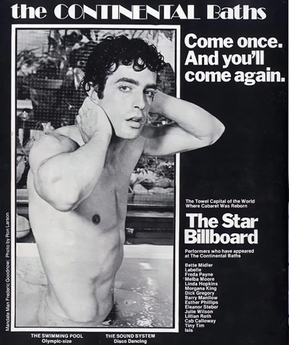
The Continental Baths was a gay bathhouse in the basement of The Ansonia Hotel in New York City, which was operated from 1968 to 1976 by Steve Ostrow. It was advertised as reminiscent of "the glory of ancient Rome".

Sexual Ecology: AIDS and the Destiny of Gay Men is a 1997 book by gay activist Gabriel Rotello, who discusses why HIV has continued to infect large numbers of gay men despite the widespread use of condoms and why a number of experts believe that new HIV infections will disproportionately affect gay men in the future. Rotello examines the origins and timeline of the AIDS epidemic, drawing on epidemiology, sociology, gay history, and ecology. His conclusion is that gay men need to reduce their number of partners and increase condom use to bring the infection rate down. Rotello's central argument derives from the epidemiological concept that sexually-transmitted epidemics are the result of three factors, sometimes called the Triad of Risk: the "infectivity" of a sexually transmitted disease (STD), or how easily it spreads; the "prevalence" of that STD in a particular group, and 3. the ‘contact rate,’ or the average number of sexual partners that people have within a particular group.
During the 1960s, the United States underwent a sexual revolution. The revolution was a social and cultural movement that resulted in liberalized attitudes toward sex and morality. Social norms were changing as sex became more widely discussed in society. Erotic media, such as films, magazines, and books, became more popular and gained widespread attention nationally. Sex was entering the public domain.
Sex: The Revolution is a four-part 2008 American documentary miniseries that aired on VH1 and The Sundance Channel. It chronicles the rise of American interest in sexuality from the 1950s through the 1990s.

Gay pornography is the representation of sexual activity between males. Its primary goal is sexual arousal in its audience. Softcore gay pornography also exists; which at one time constituted the genre, and may be produced as beefcake pornography directed toward heterosexual female, homosexual male, and bisexual audiences of any gender.
Rodger Allen McFarlane was an American gay rights activist who served as the first paid executive director of the Gay Men's Health Crisis and later served in leadership positions with Broadway Cares/Equity Fights AIDS, Bailey House and the Gill Foundation.
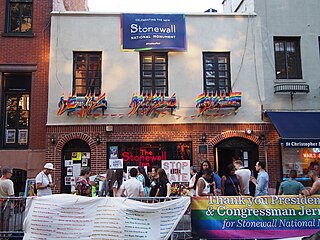
New York state, a state in the northeastern United States, has one of the largest and the most prominent LGBTQ populations in the world. Brian Silverman, the author of Frommer's New York City from $90 a Day, wrote that New York City has "one of the world's largest, loudest, and most powerful" LGBT communities", and "Gay and lesbian culture is as much a part of New York's basic identity as yellow cabs, high-rises, and Broadway theatre". LGBT travel guide Queer in the World states, "The fabulosity of Gay New York is unrivaled on Earth, and queer culture seeps into every corner of its five boroughs". LGBT Americans in New York City constitute by significant margins the largest self-identifying lesbian, gay, bisexual, and transgender communities in the United States, and the 1969 Stonewall riots in Greenwich Village are widely considered to be the genesis of the modern gay rights movement.
The Working Man Trilogy is a landmark American gay pornographic trilogy released in the late 1970s. The films were created and directed by Tim Kincaid under the pseudonym Joe Gage, with Sam Gage serving as producer on all three. The series featured universally masculine, working class male actors engaging in various sexual activities with each other, a notable divergence from the usual masculine/feminine partner roles found in earlier gay porn.

REX was an American visual artist and illustrator closely associated with gay fetish art of 1970s and 1980s New York and San Francisco. He avoided photographs and did not discuss his personal life. His drawings influenced gay culture through graphics made for nightclubs including the Mineshaft and his influence on artists such as Robert Mapplethorpe. Much censored, he remained a shadowy figure, saying that his drawings "defined who I became" and that there are "no other 'truths' out there". REX died in Amsterdam in late March 2024.














